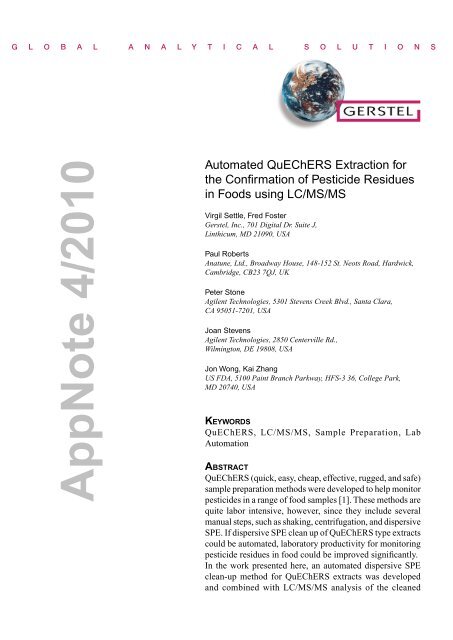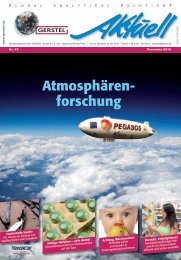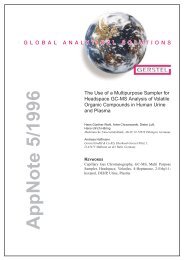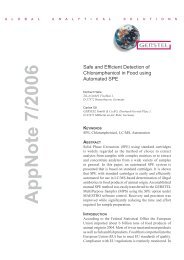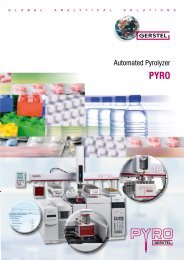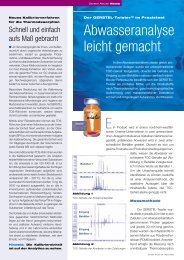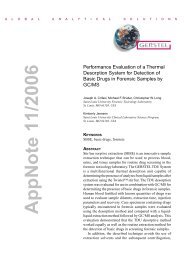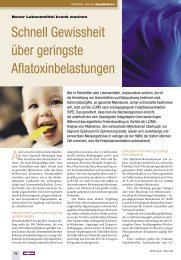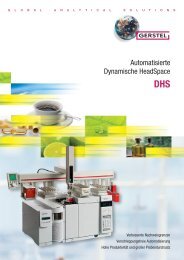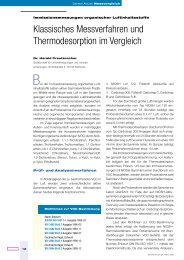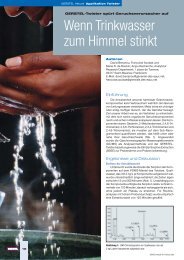AppNote-2010-04 - Gerstel
AppNote-2010-04 - Gerstel
AppNote-2010-04 - Gerstel
Create successful ePaper yourself
Turn your PDF publications into a flip-book with our unique Google optimized e-Paper software.
<strong>AppNote</strong> 4/<strong>2010</strong><br />
Automated QuEChERS Extraction for<br />
the Confi rmation of Pesticide Residues<br />
in Foods using LC/MS/MS<br />
Virgil Settle, Fred Foster<br />
<strong>Gerstel</strong>, Inc., 701 Digital Dr. Suite J,<br />
Linthicum, MD 21090, USA<br />
Paul Roberts<br />
Anatune, Ltd., Broadway House, 148-152 St. Neots Road, Hardwick,<br />
Cambridge, CB23 7QJ, UK<br />
Peter Stone<br />
Agilent Technologies, 5301 Stevens Creek Blvd., Santa Clara,<br />
CA 95051-7201, USA<br />
Joan Stevens<br />
Agilent Technologies, 2850 Centerville Rd.,<br />
Wilmington, DE 19808, USA<br />
Jon Wong, Kai Zhang<br />
US FDA, 5100 Paint Branch Parkway, HFS-3 36, College Park,<br />
MD 20740, USA<br />
KEYWORDS<br />
QuEChERS, LC/MS/MS, Sample Preparation, Lab<br />
Automation<br />
ABSTRACT<br />
QuEChERS (quick, easy, cheap, effective, rugged, and safe)<br />
sample preparation methods were developed to help monitor<br />
pesticides in a range of food samples [1]. These methods are<br />
quite labor intensive, however, since they include several<br />
manual steps, such as shaking, centrifugation, and dispersive<br />
SPE. If dispersive SPE clean up of QuEChERS type extracts<br />
could be automated, laboratory productivity for monitoring<br />
pesticide residues in food could be improved significantly.<br />
In the work presented here, an automated dispersive SPE<br />
clean-up method for QuEChERS extracts was developed<br />
and combined with LC/MS/MS analysis of the cleaned
extracts. Extracts were prepared with commercially<br />
available kits from Agilent Technologies. Automation<br />
was achieved using a GERSTEL MPS XL PrepStation<br />
configured with an Anatune CF-100 centrifuge.<br />
Analytical methodology for confirming the presence<br />
of a variety of pesticides in a range food samples<br />
was developed using an Agilent G6460A Triple<br />
Quadrupole Mass Spectrometer. The sensitivity and<br />
selectivity of LC/MS/MS enable sufficiently low<br />
limits of determination to meet acceptance criteria for<br />
reporting the maximum residue levels (MRLs) that are<br />
established by regulatory agencies.<br />
The ability to automate the dispersive SPE clean-up<br />
of QuEChERS extracts combined with introduction<br />
of the cleaned extract directly to the LC/MS/MS<br />
system results in improved laboratory productivity<br />
by streamlining the complete analytical process.<br />
INTRODUCTION<br />
Automated QuEChERS clean-up of fruit and vegetable<br />
extracts combined with LC/MS/MS determination of<br />
pesticides was previously reported [2]. Recovery and<br />
reproducibility data based upon matrices spiked at<br />
concentrations of 10 ng/g showed that the system used<br />
was suitable for automating the QuEChERS dispersive<br />
SPE clean-up.<br />
Recently, interest was expressed in an automated<br />
method to determine the presence of pesticide residues<br />
in botanical samples. Some botanical matrices have<br />
physical properties that pose a real challenge. When<br />
using the automated QuEChERS clean-up procedure,<br />
such matrices can make it difficult to reach the low<br />
limits of determination required in order to meet<br />
acceptance criteria for reporting the maximum residue<br />
levels (MRLs) as established by regulatory agencies.<br />
This study focuses on the automated extraction used in<br />
the second step of the QuEChERS procedure, which<br />
is followed by LC/MS/MS analysis of the extract.<br />
The aim is to provide high throughput analysis for<br />
the confirmation of pesticide residues in botanical<br />
matrices. Automated QuEChERS extractions were<br />
performed by the GERSTEL MPS XL autosampler<br />
using Agilent’s SampliQ QuEChERS dispersive<br />
SPE sorbent blend suggested for fatty matrices. The<br />
resulting extracts from the automated QuEChERS<br />
process were introduced into an Agilent 6460 LC/<br />
MS/MS instrument.<br />
EXPERIMENTAL<br />
Materials. Stock solutions containing the pesticide<br />
compounds listed in Table 1 in acetonitrile were<br />
prepared and provided by the FDA. Calibration<br />
standards and matrix matched standards were prepared<br />
by making appropriate dilutions of the pesticide stock<br />
solutions using mobile phase, blank hop extract,<br />
or blank ginseng extract resulting in the following<br />
concentrations: 0.5, 1, 2, 5, 10, 20, 50, 100, 200, 500,<br />
and 1000 ng/mL.<br />
Crude acetonitrile extracts of pesticide-fortified<br />
samples, incurred samples, and blank matrix samples<br />
based on both Hops and Ginseng root were prepared and<br />
provided by the FDA. These samples were generated<br />
using QuEChERS extraction salts for the EN Method<br />
(Agilent p/n: 5982-5650) and the recommended sample<br />
preparation method supplied with the salts [3].<br />
Instrumentation. All automated PrepSequences were<br />
performed using an MPS 2XL dual head, multi-purpose<br />
sampler configured for automated QuEChERS-LC/<br />
MS/MS analysis as shown in Figure 1.<br />
Figure 1. MPS 2XL dual head, multi-purpose<br />
sampler configured for automated QuEChERS-<br />
LC/MS/MS analysis.<br />
AN/<strong>2010</strong>/4 - 2
Table 1. 200+ pesticides monitored using the automated QuEChERS-LC/MS/MS method.<br />
3-Hydroxycarbofuran Acephate Acetamiprid Acibenzolar-S-methyl Alanycarb<br />
Aldicarb Aldicarb sulfone Aldicarb sulfoxid Aspon Avermectin B1a<br />
Avermectin B1b Azadirachtin Azoxystrobin Benalaxyl Bendiocarb<br />
Benfuracarb Benoxacor Benthiavalicarb Benzoximate Bifenazate<br />
Bifenthrin Bitertanol Boscalid Bromuconazole-1 Bromuconazole-2<br />
Bupirimate Buprofezin Butafenacil Butocarboxym Butoxycarboxim<br />
Cadusafos Carbaryl Carbendazim Carbetamid Carbofuran<br />
Carboxine Carfentrazone-ethyl Chlordimeform Chlorfenvinphos-beta Chlorfl uazuron<br />
Chlorotoluron Chloroxuron Clethodim Clofentezine Clothianidin<br />
Coumaphos Cumyluron Cyanazine Cyanophos Cyazofamid<br />
Cycluron Cymoxanil Cyproconazole Cyprodinil Cyromazine<br />
d10-Diazinon d6-Dichlorvos d6-Dimethoate d6-Diuron d6-Linuron<br />
d6-Malathion Daimuron Dazomet Deltamethrin Diazinon<br />
Dichlorvos Dicrotophos Diethofencarb Difenoconazol Difl ubenzuron<br />
Dimethenamid Dimethoat Dimethomorph A Dimethomorph B Dimoxystrobin<br />
Diniconazole Dinotefuran Dioxacarb Disulfoton Dithiopyr<br />
Diuron Dodemorph 1 Dodemorph 2 E-Fenpyroximate Emamectin B1a<br />
Emamectin B1b Epoxiconazole Eprinomectin B1a EPTC Esprocarb<br />
Ethidimuron Ethiofencarb Ethion Ethiprole Ethirimol<br />
Ethofumesate Ethoprop Etobenzanid Etofenprox Etoxazole<br />
Famoxadone Fenamidone Fenarimol Fenazaquin Fenbuconazol<br />
Fenhexamid Fenoxanil Fenoxycarb Fenpropathrin Fenpropimorph<br />
Fenuron Flonicamid Flucarbazone Fludioxinil Flufenacet<br />
Flufenoxuron Flumetsulam Flumioxazin Fluometuron Fluquinconazole<br />
Flusilazol Fluthiacet-methyl Flutolanil Flutriafol Forchlorfenuron<br />
Formetanate Fuberidazole Furalaxyl Furathiocarb Heptenophos<br />
Hexaconazol Hexafl umuron Hexythiazox Hydramethylnon Imazalil<br />
Imazapyr Imibenconazole Imidacloprid Indanofan Indoxacarb<br />
Ipconazole Iprovalicarb Isocarbamid Isofenfos Isopropalin<br />
Isoproturon Isoxaben Isoxafl utole Kresoxim-methyl Lactofen<br />
Leptophos Linuron Lufenuron Mandipropamid Mefenazet<br />
Mepanipyrim Mepronil Metalaxyl Metconazole Methabenzthiazuron<br />
Methamidophos Methiocarb Methomyl Methoprotryne Methoxifenozid<br />
Metobromuron Metribuzin Mevinphos Mexacarbate Molinate<br />
Monocrotophos Monolinuron Moxidectin Myclobutanil Neburon<br />
Nitenpyram Norfl urazon Novaluron Nuarimol Omethoate<br />
Oxadixyl Oxamyl Paclobutrazol Penconazole Pencycuron<br />
Phenmedipham Picoxystrobin Piperonyl butoxide Pirimicarb Prochloraz<br />
Promecarb Prometon Prometryn Propachlor Propamocarb<br />
Propargite Propazine Propham Propiconazole Propoxur<br />
Pymetrozine Pyracarbolid Pyraclostrobin Pyridaben Pyrimethanil<br />
Pyriproxyfen Quinoxyfen Rotenone Sebuthylazine Secbumeton<br />
Siduron Simazine Simetryn Spinosyn A Spinosyn D<br />
Spirodiclofen Spiromesifen Spiroxamin Sulfentrazone Tebuconazole<br />
Tebufenozide Tebufenpyrad Tebuthiuron Tefl ubenzuron Temephos<br />
Terbumeton Terbutryn Terbutylazine Tetraconazole Tetramethrin cis<br />
Thiabendazole Thiacloprid Thiametoxam Thiazopyr Thidiazuron<br />
Thiobencarb Thiofanox Thiophanate-methyl Triadimefon Triadimenol<br />
Trichlamide Trichlorfon Tricyclazole Trifl oxystrobin Trifl umizole<br />
Trifl umuron Triticonazole Uniconazole Vamidothion Zoxamide<br />
AN/<strong>2010</strong>/4 - 3
QuEChERS acetonitrile extract pretreatment.<br />
• Pipette 1mL of the acetonitrile extract obtained following the 1st centrifugation step of the QuEChERS<br />
sample preparation method into a 2 mL glass autosampler vial containing the sorbent blend from Agilent’s<br />
SampliQ QuEChERS dispersive SPE kit for fatty samples, AOAC (p/n: 5982-5122).<br />
• Place the sample onto a tray on the GERSTEL MPS 2XL dual head, multi-purpose sampler configured for<br />
automated QuEChERS-LC/MS/MS.<br />
The automated QuEChERS extraction consisted of the following steps:<br />
Automated QuEChERS Prep Sequence.<br />
• Agitate the sample vial for 1 minute using the Anatune CF-100 centrifuge.<br />
• Centrifuge the sample vial at 575 g for 3 minutes using the Anatune CF-100 centrifuge.<br />
• Filter 500 μL of the resulting supernatant through a 0.45 μm GERSTEL format syringe filter.<br />
• Combine 100 μL of the resulting filtrate with 400 μL of mobile phase A in a clean 2 mL vial.<br />
• Agitate the sample vial using the Anatune CF-100 centrifuge for 30 seconds.<br />
• Inject 2 μL into the LC/MS/MS system.<br />
Figure 2 shows a Prep Sequence used to perform an automated QuEChERS-LC/MS/MS run.<br />
Figure 2. Example Prep Sequence for Automated QuEChERS LCMSMS Analysis.<br />
AN/<strong>2010</strong>/4 - 4
Preparation of all standards was automated using the<br />
MPS 2XL dual head, multipurpose sampler configured<br />
for automated QuEChERS-LC/MS/MS analysis as<br />
follows:<br />
Preparation of Calibration Standards and Matrix<br />
Matched Standards.<br />
• Transfer 100 μL of previously extracted matrix<br />
blank or 100 % acetonitrile into an empty 2 mL<br />
autosampler vial.<br />
• Transfer 250 μL of mobile phase A into the vial.<br />
• Transfer 150 μL of the respective standard stock<br />
solution into the vial.<br />
• Agitate the vial using the Anatune CF-100<br />
centrifuge for 30 seconds.<br />
All analyses were performed using an Agilent 1290<br />
HPLC, an Agilent 6460 Triple Quadrupole Mass<br />
Spectrometer with electrospray source and Jet Stream<br />
Option and a GERSTEL MPS 2XL autosampler<br />
configured with Active WashStation. Sample injections<br />
were made using a 6 port (0.25 mm) Cheminert C2V<br />
injection valve fitted with a 2 μL stainless steel sample<br />
loop.<br />
Analysis conditions LC.<br />
Mobile Phase:<br />
A - 5 mM ammonium formate<br />
in water with 0.01 % formic acid<br />
B – 0.01 % formic acid<br />
in acetonitrile<br />
Gradient: Initial 94 % A / 6 % B<br />
0.3 min 94 % A / 6 % B<br />
14 min 5 % A / 95 % B<br />
17 min 5 % A / 95 % B<br />
Pressure:<br />
Flowrate:<br />
Runtime:<br />
Post time:<br />
Column:<br />
Oven: 55°C<br />
Inj. volume: 2 μL<br />
600 bar<br />
500 μL/min<br />
17 min<br />
2.5 min<br />
2.1 mm x 100 mm, 1.8 μm,<br />
Zorbax Eclipse Plus C18 RRHT<br />
(Agilent)<br />
Analysis conditions MS.<br />
Operation: Electrospray positive mode<br />
(Jet Stream)<br />
Time Filter Width: 0.<strong>04</strong> min<br />
Scan Type: Dynamic MRM<br />
Delta EMV: 0 V<br />
Cycle Time: 660 ms<br />
Gas Temperature: 225 °C<br />
Gas Flow (N2): 10 L/min<br />
Nebulizer pressure: 25 psi<br />
Sheath Gas (N2): 350 °C<br />
11 L/min<br />
Capillary voltage: 4500 V<br />
Nozzle Voltage: 500 V<br />
The mass spectrometer acquisition parameters and<br />
respective quantifier/qualifier ion transitions were<br />
chosen using the pesticide database option available for<br />
the MassHunter B.03.01 software. Table 1 provides a<br />
list of the more than 200 pesticides that were monitored<br />
using this single LC/MS/MS method. A retention time<br />
window value of 0.5 minute was used for each positive<br />
ion transition being monitored during the course of the<br />
dynamic MRM experiment.<br />
RESULTS AND DISCUSSION<br />
Figure 3 shows a representative overlay mass<br />
chromatogram resulting from a QuEChERS extract<br />
of a pesticide-fortified hop sample. More than 200<br />
different pesticides were successfully determined in<br />
this botanical matrix using the automated QuEChERS-<br />
LC/MS/MS method.<br />
AN/<strong>2010</strong>/4- 5
Figure 3. Representative Mass Chromatograms for low QC sample.<br />
Figure 4 shows the a representative calibration curve resulting from automated preparation of neat standards.<br />
The calibration curves were shown to be linear from at least 1.00 to 200 ppb for the pesticides monitored, using<br />
a linear, 1/x regression method.<br />
Figure 4. Representative calibration curve from automated neat standard preparation: thiabendazole.<br />
Figures 5 through 7 show representative overlay mass chromatograms of neat, hop matrix matched, and ginseng<br />
matrix matched calibration standards respectively, all at a concentration of 10 ppb. The calibration standards<br />
were prepared automatically by the MPS 2XL.<br />
AN/<strong>2010</strong>/4 - 6
Figure 5. Representative overlay mass chromatogram for a 10 ppb neat standard.<br />
Figure 6. Representative overlay mass chromatogram for a 10 ppb hops matrix matched standard.<br />
AN/<strong>2010</strong>/4 - 7
Figure 7. Representative overlay mass chromatogram for a 10 ppb ginseng matrix matched standard.<br />
The total time required per sample to perform the QuEChERS extraction was 15 minutes. This was shorter<br />
than the LC-MS/MS analysis run, enabling the MPS system to complete preparation of the next sample during<br />
the LC-MS/MS run. Sample preparation and analysis are easily synchronized using the MAESTRO software<br />
providing “just in time” sample preparation and maximizing sample throughput.<br />
CONCLUSIONS<br />
In this study, we were able to demonstrate:<br />
• Successful monitoring of more than 200 pesticides<br />
in botanical matrix samples using an automated<br />
QuEChERS extraction method coupled to LC/<br />
MS/MS analysis using the Agilent 6460 Triple<br />
Quadrapole Mass Spectrometer.<br />
• Automation of both the QuEChERS method and<br />
the preparation of standards using the GERSTEL<br />
MPS 2XL dual head robotic sampler.<br />
• The “just-in-time” sample preparation capability<br />
included in the MAESTRO software enables highly<br />
efficient QuEChERS extraction and analysis.<br />
REFERENCES<br />
[1] Fully Automated QuEChERS clean-up and LC/<br />
MS-QQQ analysis of pesticides in Fruits and<br />
Vegetables. Anatune Chromatography Technical<br />
Note, No. AS90, Paul H. Roberts, Anatune Ltd.,<br />
2009.<br />
[2] Determination of pesticide residues in foods<br />
by acetonitrile extraction and partitioning with<br />
magnesium sulfate: collaborative study. Lehotay,<br />
SJ., J. AOAC Int. 90, 485 (2007)<br />
[3] Agilent SampliQ QuEChERS Kit<br />
brochure. Document number 5990-3562EN<br />
www.chem.agilent.com<br />
AN/<strong>2010</strong>/4 - 8
AN/<strong>2010</strong>/4 - 9
GERSTEL GmbH & Co. KG<br />
Eberhard-<strong>Gerstel</strong>-Platz 1<br />
D-45473 Mülheim an der Ruhr<br />
Germany<br />
+49 (0) 208 - 7 65 03-0<br />
+49 (0) 208 - 7 65 03 33<br />
gerstel@gerstel.com<br />
www.gerstel.com<br />
GERSTEL Worldwide<br />
GERSTEL, Inc.<br />
701 Digital Drive, Suite J<br />
Linthicum, MD 21090<br />
USA<br />
+1 (410) 247 5885<br />
+1 (410) 247 5887<br />
sales@gerstelus.com<br />
www.gerstelus.com<br />
GERSTEL AG<br />
Wassergrabe 27<br />
CH-6210 Sursee<br />
Switzerland<br />
+41 (41) 9 21 97 23<br />
+41 (41) 9 21 97 25<br />
gerstel@ch.gerstel.com<br />
www.gerstel.ch<br />
GERSTEL K.K.<br />
1-3-1 Nakane, Meguro-ku<br />
Tokyo 152-0031<br />
SMBC Toritsudai Ekimae Bldg 4F<br />
Japan<br />
+81 3 5731 5321<br />
+81 3 5731 5322<br />
info@gerstel.co.jp<br />
www.gerstel.co.jp<br />
GERSTEL LLP<br />
Level 25, North Tower<br />
One Raffles Quay<br />
Singapore <strong>04</strong>8583<br />
+65 6622 5486<br />
+65 6622 5999<br />
SEA@gerstel.com<br />
www.gerstel.com<br />
GERSTEL Brasil<br />
Av. Pascoal da Rocha Falcão, 367<br />
<strong>04</strong>785-000 São Paulo - SP Brasil<br />
+55 (11)5665-8931<br />
+55 (11)5666-9084<br />
gerstel-brasil@gerstel.com<br />
www.gerstel.com.br<br />
Information, descriptions and specifications in this<br />
Publication are subject to change without notice.<br />
GERSTEL, GRAPHPACK and TWISTER are registered<br />
trademarks of GERSTEL GmbH & Co. KG.<br />
© Copyright by GERSTEL GmbH & Co. KG<br />
Awarded for the<br />
active pursuit of<br />
environmental sustainability


